These show notes feature everything we cover in this episode. Premium Members: download this exclusive ad-free show notes cheat sheet PDF. Not a member yet? Learn more and join the Genealogy Gems and Elevenses with Lisa family here.

Who doesn’t love a good genealogical surprise? Sometimes we discover something we overlooked the first time around. Other times we find gems in places we never expected. Google Books is one of those places full of unexpected surprises.

with Lisa Louise Cooke
Google Books is a free online catalog of over 25 million books, 10 million of which are digitized and searchable. The collection is international in scope.
You can search at the stand-alone website. You can also start your search at Google.com and then select Books results on the search results page.
While you would expect to find books at Google Books, you may be surprised to discover there it also includes many other types of published materials. Here are 10 surprising things you can find at Google Books. Watch the video and follow along in the article below.
The final issue of Ancestry magazine was published in 2010. Though times and technology change, core genealogical methodology stays much the same. Browse or search past issues spanning 1994 through 2010 at Google Books for free. You’ll also find countless other magazine titles including Life magazine (1953-1972).
Quickly access all the issues of Ancestry magazine at Google Books.
Browse all of the magazines at Google Books.
An ideal way to fill in between census enumerations is with city directories. Typically published yearly but sometimes irregularly, they are an invaluable source for information about your ancestors. You might find listed their place of employment and spouse’s name in addition to address and phone number.
Search Tip: Target city directories specifically by searching for the name of the city in quotation marks. Google interprets quotation marks to mean that you want that word exactly as written to appear in each returned result. Next add the phrase city directory, again in quotes. To ensure you don’t miss directories that include additional words between city and directory, place an asterisk between the words.
Here’s how your search will look: “Nashville” “city * directory”
This search operator tells Google that the phrase may also include a word or two between city and directory. An example might be The Nashville City and Business Directory.
When we hear the word almanac we often automatically think of the yearly Old Farmer’s Almanac. However, almanacs of the 19th century and earlier sometimes also included information on local residents and businesses. It’s worth taking a look to see if your ancestor’s community published almanacs. Businesses and other organizations also published almanacs.
It’s not uncommon for every person at some point in their life to interact with the government. Those interactions create paperwork, and that paperwork may have been published. In Google books, search for probate documents, hearings and other types of government generated works in combination with the names of your ancestors, their businesses, and other organizations with which they were associated.
The digitized items on Google Books are often there because they either fall within the public domain (published prior to 1924). Consequently, there is a very good chance that the county history published in your ancestor’s area is digitized and available on Google Books. These books are a wealth of historical information about families and communities.
There’s a good chance that sometime in the past someone has researched a family line that connects to your family tree. These genealogies may be published in a compiled family history. Since the phrase compiled family history will probably not be in the title of the book, try this search approach:
1. Search for the word genealogy (no quotation marks) and a surname (with quotation marks)
2. Filter to Free Google eBooks
3. Filter by time frame (for example 19th century)
The Google News Archive was a newspaper digitization project that was discontinued several years ago. The archive remains but is very difficult to search. The good news is that those digitized newspapers are now included in Google Books with its powerful search engine. Start by running a search and then on the results page filter Document Type to Newspapers. Use the Share a Clip clipping tool (found in the three stacked dots button on the digitized book page) to clip articles.
Newspapers may appear in the old Classic View of Google Books (as they do at the time of this writing.) If so, use the search box in the column on the left side of the page to search within the newspaper.
Search Tip: Save time by visiting the Google News Archive to see which newspapers are included and the years that they cover.
The oldest genealogy journal has been published quarterly by the New England Historical and Genealogical Society since 1847. Since then many other societies such as the Genealogical Society of Utah have regularly published journals. These journals often list families and sources and are an invaluable resource to genealogists today. Family Associations also often publish journals.
Try a simple search of genealogy journal to start browsing. Then try adding a surname, state, or country or combination of those. Filter down to Free Google eBooks to view only free digitized publications.
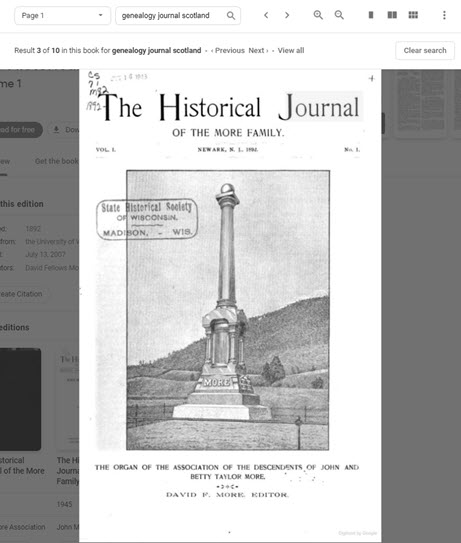
The Historical Journal of the More Family. United States: John More Association, 1892.
Old maps can be found in many of the surprising items we’ve found so far. County Histories in particular are a wonderful resource of old maps. Many times, they will include plat maps that even include the owners name written on the property. Many maps may be one-of-a-kind.
A quick and easy way to spot maps within a book is to use Thumbnail View. You’ll find the Thumbnail View button (which looks like a checkerboard or collection of six squares) at the top of the screen when viewing a digitized book. Once clicked, your view will change from a single page to many pages at once. This makes it very easy to scroll and spot maps. You can also try looking through the Contents menu for Maps.
Use the Share a Clip feature (mentioned in #7) to clip the map. In the pop-up box, click the Copy button next to the image link. Paste the link in a new browser tab and hit Enter on your keyboard. On a PC, right-click the image and save it to your computer by selecting Save Image As.
Like old maps, there are many photographs and images in old digitized books at Google Books. These could include photos, engravings and drawings of your ancestors, their homes or other items relating to your family history. Follow the directions in #9 to find and save photos and images.
When reviewing a digitized book, look for the Contents menu at the top of the screen. Here you’ll find addition options to jump to different parts of the book such as topics or chapters.
In the new Google Books user interface, you will find the digitized book is overlayed over the catalog entry for the book. The search box at the top of the screen is for searching only within that book. To close the book and view the catalog entry, click the X in the upper right corner of the screen.
To remove the yellow highlighted items, you searched for from a book and start a new search, click the Clear Search button.
Translate foreign language text by using the clipping tool. While viewing a digitized page, click the three stacked dots and select Share a Clip. Using your mouse, draw a box around the text you want to translate. In the Share this Clip pop-up window click the Translate button.
How to filter your search results down to only free digitized book: On the search results page you should see that the Tools button is greyed out (if it is not, click it) and in the drop down menu click Any Books and select Free Google eBooks.
How to cite books in Google Books: Close the digitized book to reveal the book’s catalog entry page. In the About this edition click the Create Citation button. Copy the desired source citation.
One of the advantages of tuning into the live broadcast of each Elevenses with Lisa show is participating in the Live Chat and asking your questions.
From Carolyn: Can you put in a year range for the city directory search
From Lisa: Yes, you can use the numrange search operator when searching Google Books. Example: “Nashville” “city * directory” 1850..1900
From Regina: What if you have a really common surname?
From Lisa: Common names pose a challenge but you can find them too! It takes a bit more strategy, and I cover that extensively in my book The Genealogist’s Google Toolbox.
From Mary: Could you find diaries, journals, and manuscripts? What would it be under?
From Lisa: If the items were formally published then there is definitely a possibility of finding them in Google Books. Run a search on diary and filter down to Free Google eBooks and you will see many examples. From there, you can try adding names, places, etc.
From Kathryn: When you clip a map or image, how can you add the citation of the book?
From Lisa: Click the X to close the digitized book. This will reveal the book’s catalog entry page. In the About this edition click the Create Citation button. Copy the desired source citation. You can then paste it into the document where you are using the clipping, or paste it into the meta data (Properties) of the image file.
From Georgiann: Sometimes I get so overwhelmed with the ALL of this good information. Lisa, are you cloned so I can have you sit next to me to calm me down as I start?
From Lisa: Well, as you heard in this episode it turns out I don’t have a twin, LOL! However, Premium Membership is the next best thing. Then you can have me “on demand” all year long.
The places where your ancestors lived can tell you a lot about their lives. I’m going to show you a free and easy technique for plotting land in Google Earth.
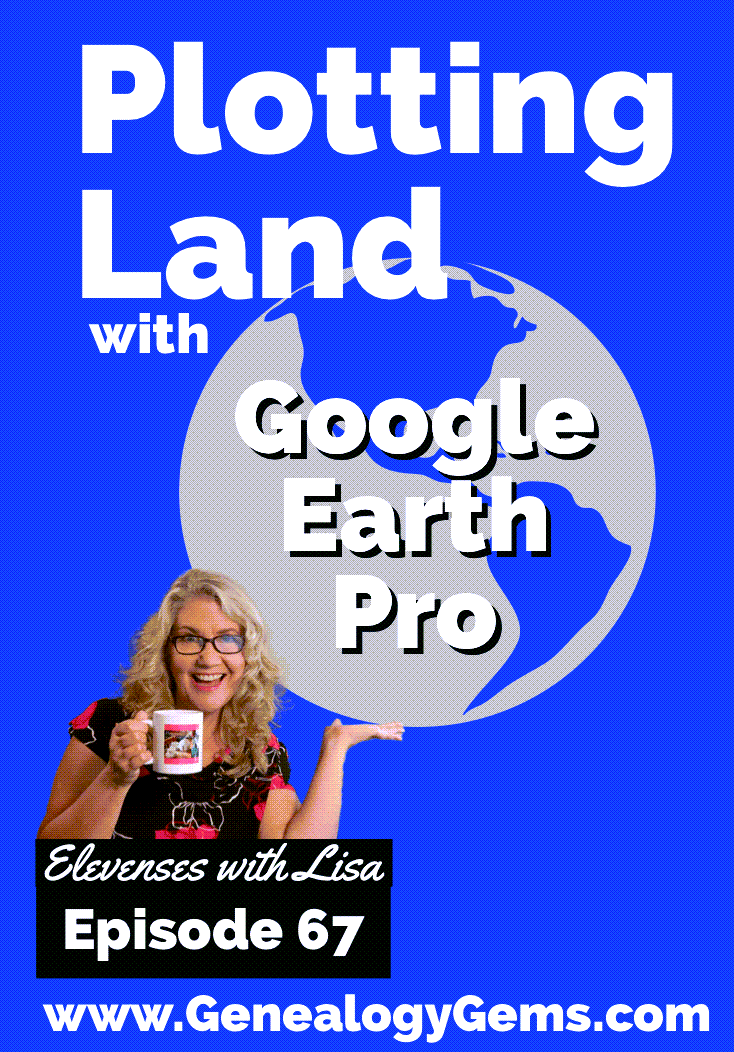
episode 67
Would you like to be able to find your ancestor’s property on a map today? Keep reading and watch the video to learn how. We’re going to take U.S. government survey legal land descriptions found in sources such as Federal Land Patents and quickly and easily plot the boundaries in Google Earth Pro. I’ll also show you an easy way to do it for property in Canada too.

(PREMIUM MEMBERS: Get your ad-free PDF cheat sheet for this episode in the Resources section at the bottom of this page. Not a member yet? Click here to join the Genealogy Gems family and get all the benefits.)
In the video I show you how to plot the boundaries of a piece of land in Google Earth. We’re going to take U.S. government survey legal land descriptions found in sources such as Federal Land Patents and quickly and easily plot the boundaries in Google Earth Pro. I’ll also show you an easy way to do it for property in Canada too. These strategies come from my book The Genealogist’s Google Toolbox,
These days there are actually three versions of Google Earth:
All are free, but they are not the same. The app and web browser versions are sort of “Google Earth lite.” The software is what you want because it has all the bells and whistles that will allow you to do all the things I’m going to show you today.
Plotting legal land descriptions in Google Earth has its advantages. If you’re plotting the land of your ancestors, you’ll be able to see what the area looks like today and what the current street names are. In Google Earth you’ll also have access to additional tools that you can use in conjunction with the boundaries you’re going to create, such as historic maps, area photos, and a wide range of data sets that provide more information about the area.
The first thing to do is check to make sure you have the most current version of Google Earth on your computer. Again, we’re using the software so you need to do this on your desktop or laptop computer. You want to make sure you have Google Earth Pro – LINK – A tell tale sign that you don’t is if the Google Earth globe icon on your desktop is grey and not blue. Open it and in the menu go to Help > About Google Earth. Here it should say Google Earth Pro and you can see the version number.
Check the current version number here, and if you don’t already have the program, go ahead and download it.
Now that you have it on your computer, open it up and leave it running in the background. You’ll need a decent internet connection for it to run.
Next pull up the legal land description that you want to plot. Here’s one that I have for some property owned by George Burket. I found this at the Bureau of Land Management Government Land Office Records website. This free website is where you can search for land patent that your ancestors once held.
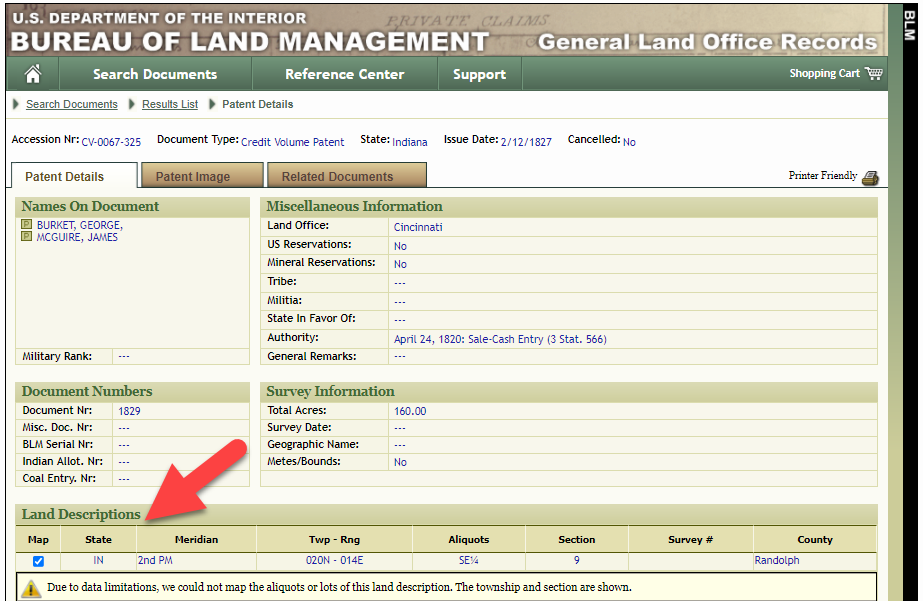
Legal land description at GLO
Even though the Bureau of Land Management places it on the map on their website, you can’t download this or add to it. The advantage of plotting this in Google Earth is that you will have access to much more geographic data, you can add many more details to the map, you can use it in conjunction with other related mapping work that you’re doing, and you can save and share it.
This description gives us the exact coordinates of the property. Jot down the land description or keep it open in your browser tab so you can refer to it.
In a new browser tab, we’re going to type in http://www.earthpoint.us. This will take us to the Earth Point website.
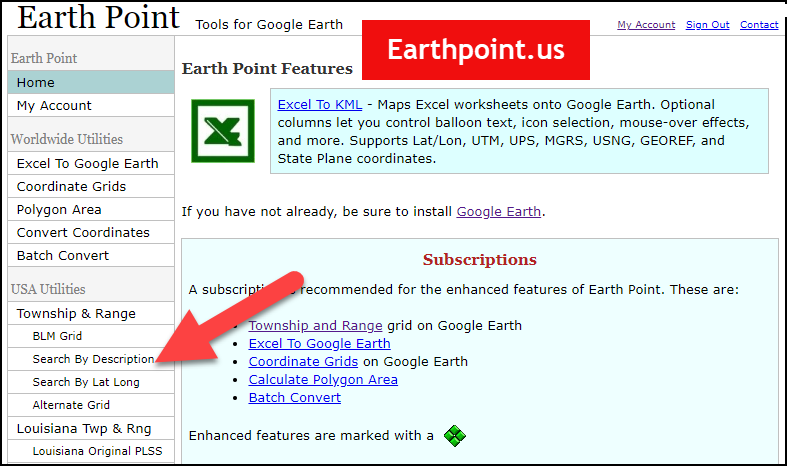
Search by legal land description at Earth Point
This website is free, although some of the features are available only with a paid subscription. Thankfully, the tool for plotting your ancestor’s land patent is free. Some of the free features do require that you sign up for a free account. The feature we are going to use currently does not.
On the Township and Range – Search by Description page you will see a field for each piece of information found in the land description. It’s important to enter this information in the order presented starting with the State. Select the state from the drop-down menu. Pause a moment to allow the fields to recalculate. This allows the appropriate data to be loaded into the next field based on your selection.
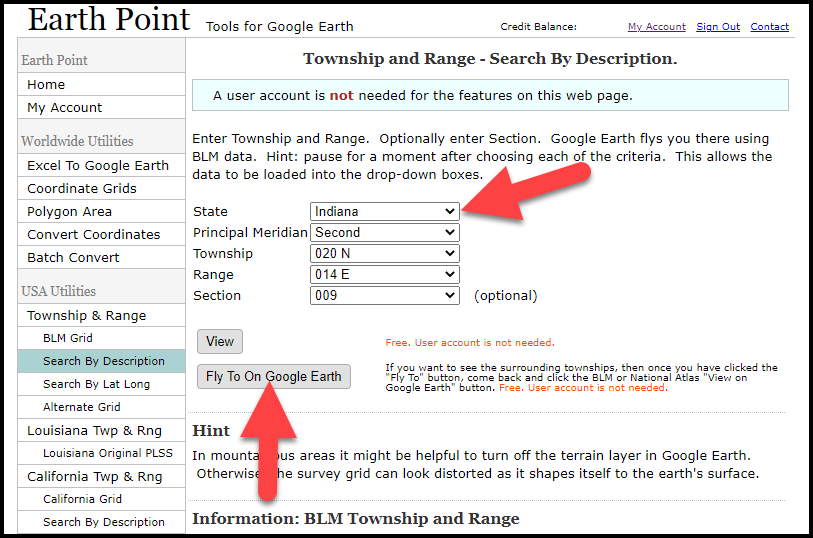
Entering data at Earth Point
After you have made each selection, click the Fly to on Google Earth button. This will generate a KML file which can be saved to your computer. KML stands for Keyhole Markup Language, which is the file type that Google Earth uses and understands. KMZ are zipped KML files which also are used by Google Earth.
Save the file to the desired location on your hard drive. Then click the file to open it. It will automatically open in Google Earth (which you already have open). The KML file is now located in your Temporary Places folder in the Places panel. The land is has now been automatically plotted on the map.
The orange outline is the township. In this example it is township T20N R14E. Click the orange ball in the center of the township for details. In the details you’ll find the total number of acres in the township, the latitude and longitude coordinates for the center of the township and corners.

Township in Google Earth
The pink / magenta outline is the Section where the property is. Click the pink center dot for the details:
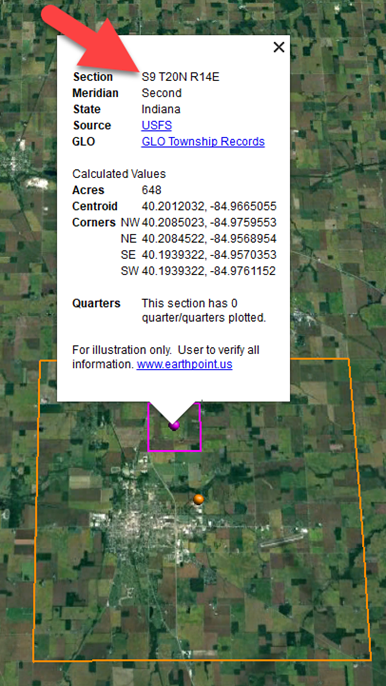
Land section in Google Earth
In this example Section 9 consists of 648 acres.
Notice that Earth Point was able to plot the land down to the Section level. However George Burket did not own the entire section. We must return to the land description for the Aliquots.
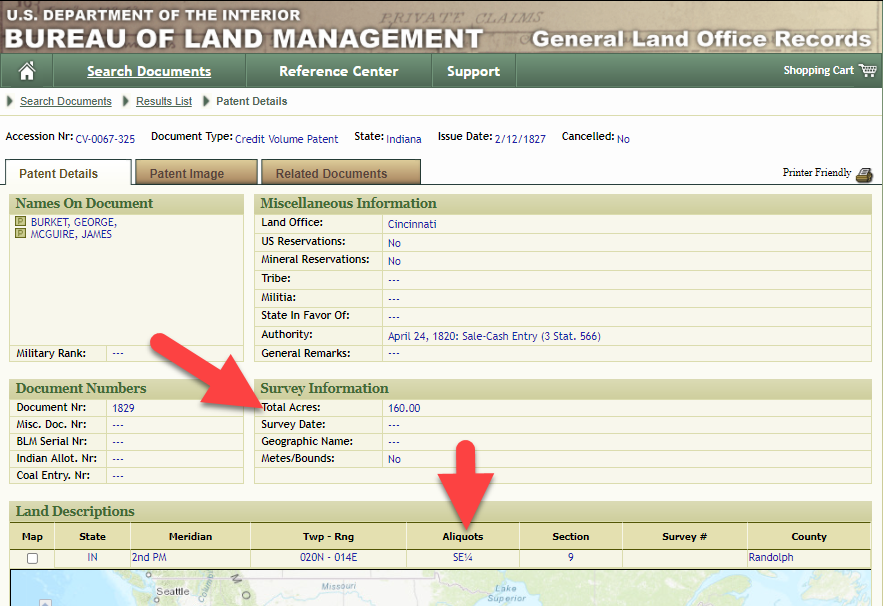
Aliquots in Legal Land Description
In this example, the land was the southeast quarter (SE1/4) of section 9. The land was a total of 160 acres.
We can use the Polygon tool in Google Earth to plot the 160 acres. In the toolbar, click the Polygon tool. This will open the New Polygon dialog box. Type a title, description and source citation.
As you hover your mouse over the map you will notice that the cursor is now a square shape. Click the screen on each of the four corners one at a time in order to set the four corners of the property – in this case the southeast quarter of the section. Once you have drawn the shape you can click on the handle on any corner to adjust precisely.
Click the Style / Color tab in the New Polygon dialog box to adjust the color and opacity of the acreage polygon. You can add color and thickness to the outline, and color and opacity to the fill of the shape. When you have it set the way you want it, click OK to close the New Polygon box. The Polygon is now set.
On the left side of the Google Earth screen you will see a series of panels: Search, Places and Layers. At the bottom of the Places panel is the Temporary folder. This is where the KML file was placed when it was opened. However, like its name implies, this is a temporary location. If you want to keep it, you’ll need to move it to a filed location within the Places panel. This will not change the position of the polygon on the map, only where it is filed and saved in the Places panel.
To file a polygon, click on the file in the Places panel, drag it to the desired location, and drop it. Next, go the main menu and click File > Save My Places. This will save your work so that when you close the program it will not be lost. Google Earth doesn’t auto-save.
The polygon plotting the acreage will be visible on the map when the box is checked in the Places panel. If you uncheck the box for the polygon it will still be there, but it will not be visible on the map. This allows you to create and save many items of interest without always having to have them displayed and cluttering up the map in Google Earth.
After your land polygon has been set, you may want to rename it. There are two ways to do this:
You can also restyle the polygon and edit the text. Start by going to the Places panel and click the arrow pointing at the Polygon’s globe icon. This will open it and show the nested content. Click to select the Polygon. Now you can right-click it (PC) and select Properties – OR – go to the menu under Edit > Properties. Either way it will reopen the Polygon dialog box so that you can make the desired changes. When you’re done, click the OK button to close the Polygon.
Snagit is the tool I used to capture the various views of the land I plotted in Google Earth. Learn more about Snag it by watching my videos and reading the show notes for episode 61 (for beginners) and episode 66 (advanced).
Although the Earth Point website doesn’t plot Canadian land, the Legal Land Description Converter website does. It can help you find land in Western Canada (British Columbia, Alberta, Saskatchewan & Manitoba) subdivided by the Dominion Land Survey (DLS) and the Alberta Township System (ATS).
These show notes feature everything we cover in this episode. Premium Members: download this exclusive ad-free show notes cheat sheet PDF. Not a member yet? Learn more and join the Genealogy Gems and Elevenses with Lisa family here.

Gwynn: I would like to know how to match plat with GPS coordinate/ current street address.
Answer: I cover how to overlay a plat map in Google Earth and discover the current street address in my book The Genealogist’s Google Toolbox.
Roger D: How exact do you need to be in picking points? Does Google snap to mid-points of lines?
Answer: Try to be as exact as you can, however as I showed in the video you can reposition them as needed. Google Earth doesn’t snap.
Lyn: Can I do this with English tithe maps?
Answer: There isn’t a website converter that I know of. However I do cover how to overlay digitized maps in Google Earth in my book The Genealogist’s Google Toolbox.
The manufacturer price is going up August 31, 2021. Now’s the perfect time to get your official Elevenses with Lisa mug.
You can also find them through the menu: Premium > Premium Videos > Elevenses with Lisa.
Show Notes: The FamilySearch Wiki is like a free encyclopedia of genealogy! In this FamilySearch Wiki tutorial, discover the wealth of information the Wiki has to offer, and learn the secrets to navigating it with ease. We’ll also cover the number #1 reason people get frustrated when searching the Wiki and how to overcome it.
RootsTech has set the class video to “private”. You can watch it on their website by going to the video page in their on-demand library. You may need to sign in to your free FamilySearch account in order to watch it.
Enjoy this special free tutorial video which was originally presented at the RootsTech conference. Download the ad-free Show Notes cheat sheet for this video class. (Premium Membership required.)
A wiki is a website that
The FamilySearch Wiki is focused on providing information for genealogy research such as:
You’re going to see many things about wiki creation and management. Not everything is relevant to you when just wanting to find information. In fact, the majority of the Help section is geared to people creating, editing and maintaining pages. Don’t worry about being a contributor. Enjoy being a user.
Keep in mind that the purpose of the Wiki is to explain where genealogical materials are located and how to get access to them. The Wiki does not have individual ancestor information. If you want to find records, start by deciding specifically what kind of records you want. Identify when and where the ancestor lived at the time the record was created. Then head to the Wiki to figure out what records are available and where they can be found.
The Wiki links to:
Topic Search: When searching for information on a specific topic such as probate records, type the topic into the Search box. As you type, a list of pages with the topic word or words in the title appears below the Search box. If one of the listed pages is the desired topic, highlight and press enter. If you don’t pick from the drop-down list you will get a results list of every page that includes the topic.
Vital records Search: FamilySearch recommends using the Guided Search for info on vital records.
Location Search in the search box: When only the name of any country, state in the U.S., province in Canada, or county in England is typed in the Search box you will be taken directly to that Wiki page. For example: If Texas is searched the result is the Texas, United States Genealogy page.
Page Title: If you happen to know the exact title of the Wiki article you want, type it in the Search Box.
Many people will search for something like marriage records, Randolph, County, Indiana, and they will get a list of results. The results don’t look as clear-cut as Google results, and they may not all be on topic. This is where we can get lost. I think probably the number one reason why people give up on the wiki is they get these kinds of search results. They realize, wait a second, this isn’t even Indiana, it’s talking about Kentucky! Why am I getting all these? It can be frustrating.
This happens because we tried to do it ourselves, with our own keywords. Remember, like most search engines, they’ve indexed their content to make it searchable, so that means they’ve already decided how they want to talk about a particular topic. Rather than just addressing marriage record first, the wiki focuses on the location. Where is this marriage record? So, focus first on the place unless you are just looking for general information on a general genealogy topic such as genealogy software.
Pre-filled suggestions will appear as you type because the wiki is going to suggest what it has in the format it has it. Again, you may want to first go to the country, state or county-level page and then look for the record type.
If you’re looking for marriage records but you don’t see them listed it might be that the word marriage isn’t the keyword the wiki uses. Or it might be that the type of record you’re looking for is a state or federal record.
Don’t be discouraged if you don’t see what you want listed in the table of contents. It may just be a keyword issue. Let the work that they’ve already done in organizing their materials guide you. You’ll be more successful and also avoid frustration. The FamilySearch Wiki is just too good of a resource to miss.
You can run three main types of searches:
Resource: Wiki Search Help Page
Generally speaking, the map is the best way to search for records and information that is rooted in a location. Start by clicking the button for the continent, such as North America. From there, select the county from the menu, such as United States, then drill down by state. This will take you to the Wiki entry for that state.
If you’re really new to research in a particular location, start with the guided research link on the location’s wiki page. You may also see links to research strategies, record finder, and record types.
Getting Started section – links to step-by-step research strategies and the most popular records.
The county pages are where the real magic happens because many records such as birth, marriage, death, and court records are typically available at the county level. There you’ll find out how to contact or visit the current county courthouse. Look for Boundary Changes on the page. Use your computer’s Find on Page feature by pressing Control + F (PC) or Command + F (mac) on your keyboard to more quickly find words like Boundary on the page.
Many record collections have their own page on the Wiki. As you type, these pages will populate in the drop-down list. Example: German Census Records. Take a moment to read through the page and you’ll discover some important information that will save you time and headaches, such as:
There are a couple of actions we may want to take before going on to search for records. Here are a few:
Click on the Category to see what else is attached to this category – in this case we see some example images that are helpful in interpreting German census forms.
Click the Cite this page link in the left column if we plan to reference the page elsewhere.
Click Printable Version in the left column if we want a printable or PDF version of the page.
Explore related pages by clicking the What links here link in the column on the left. Notice it also shows if there are any other users watching the page.
Videos at Lisa Louise Cooke’s Genealogy Gems YouTube channel: